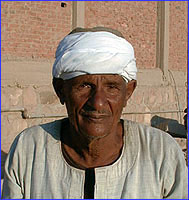
|
 |
 |
Abdel Aleem, Chief Foreman NOVA: How long have you been in the quarrying business? Aleem: Forty-eight years. NOVA: Do you think we'll get the obelisk up when we try? Aleem: One hundred percent sure, with the willing of God. NOVA: What do your men think of this project? Aleem: All of my men are preparing for the erecting of the obelisk. This is my personal crew—they always work with me. Once I am convinced of a project, they are convinced as well. They don't follow me without thinking, but they think the project is good, because I think it's good. NOVA: What sort of experience have you had pulling large pieces before? Aleem: I have moved objects up to 400 tons before, using steel rollers. NOVA: Do you use techniques borrowed from the ancient Egyptian quarrymen? Aleem: With small objects, I can use old, traditional techniques, like rollers and levers. But with a big object, I use modern machines. I look to the object, and then I think, "What is available?" I will use an old technique or a modern technique depending on what is available. Of course, I got this profession from my parents, who were using old techniques, so it's something in my blood. NOVA: Could you move the giant Unfinished Obelisk of Aswan? Aleem: I could use a modern technique to move it. To lift from the ground 1,200 tons with the ancient methods would be very difficult. But using new methods and new technology, I could lift it. There are giant cranes that can hold 350 tons. I could use three of these in order to lift it. I would have to coordinate so that the three cranes lift every millimeter at the same time. NOVA: Do you think that animals may have been used to transport the obelisks? Aleem: I believe the ancient Egyptians used the animals that existed in their time, such as cows. They also used the technique of the flood. When the tide went down, they put the object on wood by the river, then, when the water comes up, it would raise it. So they used the phenomenon of the flood, which comes at summertime, to lift up or set down an object. NOVA: How would you raise NOVA's obelisk? Aleem: I would use a huge, four-ton block as a counterweight to make the effort less. I would hang this weight to a sort of A-frame structure tied to the obelisk. NOVA: What are some of your achievements in raising heavy objects? Aleem: I have constructed a chimney 60 meters (198 feet) high without using any cranes. We built the chimney step by step—building the top piece first and then raising it up to fit the next piece. Then we lifted these top two pieces and put the third piece in and so on. I am the one who erected the giant statue of Ramses in Cairo Station. At the time, in 1953, I was helping to build a bridge in Cairo called the Giza bridge. The government decided to move the statue of Ramses from Sakkara, a village nearby Cairo, to the main railway station in Cairo. My men and I erected this statue in 15 days, without using any modern cranes, using only primitive methods like hand cranes. It was a great achievement. Explore Ancient Egypt | Raising the Obelisk | Meet the Team Dispatches | Pyramids | E-Mail | Resources Classroom Resources | Site Map | Mysteries of the Nile Home Editor's Picks | Previous Sites | Join Us/E-mail | TV/Web Schedule About NOVA | Teachers | Site Map | Shop | Jobs | Search | To print PBS Online | NOVA Online | WGBH © | Updated November 2000 |
 Abdel Aleem
Abdel Aleem